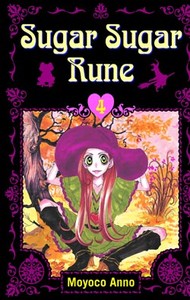Review
by Carlo Santos,Sugar Sugar Rune
G.novel 4
| Synopsis: |  |
||
Young witches Chocolat and Vanilla are best friends engaged in an earthly quest to capture people's hearts. Whoever gets the most hearts will become Queen of the Magical World—but the rivalry has become so intense that Vanilla has joined the Ogres, a faction of magic-users who were exiled from the Magical World. Guided by fellow Ogre and school heartthrob Pierre, Vanilla is mastering the sinister ways of Noir Magic, but Chocolat thinks she can still be saved. However, Chocolat must first overcome her own feelings for Pierre. Now she finds herself having to protect Vanilla and free her from the Ogres, while still capturing enough hearts to become Queen and trying to find out what really happened to her mother. |
|||
| Review: | |||
It's got magic, it's got girls, but fans of Sugar Sugar Rune know that it's already gone well past "magical girl." By Volume 3, some key events had brought the big picture into view: a political struggle between ancient magical races, a best friend's betrayal, and a heroine in search of her lineage. This follow-up volume now tries to build on that expanded world, showing Vanilla's descent into darkness and Chocolat's conflict of conscience. However, Moyoco Anno might be overstretching her ambitions here, and eventually the story falls back into episodic adventure: Chocolat faces one challenge, clears it, moves on to the next one, and so on. Yet behind the sparkly, candy-flavored façade is a dark, complex world with the potential to be more than just casting spells and chasing hearts. Still riding high on the momentum of the previous installment, Volume 4 opens with a face-to-face confrontation between the Magical World and the Ogres. This isn't just a good-versus-evil Harry Potter deal, though—Chocolat's attachment to both Pierre and Vanilla give rise to conflicted feelings, and it's hard go all out against the forces of darkness if you can still see the light in them. As the Ogres' history shows, the bad guys aren't all bad, and the good guys aren't all good. "I wonder which side is really wrong," muses Chocolat, showing surprising depth for a child protagonist. Unfortunately, that complex world-building is dropped about halfway through in favor of simpler, episodic adventures. While the later chapters still build on the story, they do it in a more conventional way—Chocolat goes questing for hearts again, and now Vanilla tries to sabotage her with her newfound Noir magic. At one point the two girls even find themselves competing for the same boy (yawn). The stakes are getting higher, but the storytelling has taken a step down. However, a cliffhanger at the end of the volume promises more dramatic turns ahead. If there's one thing that stays consistent, though, it's the colorful and fascinating characters that populate the series. Vanilla, who once lived up to her name as the prototypical good girl, has become infinitely more interesting now that she's dabbling in the dark arts. Meanwhile, Chocolat has grown well beyond the brash tomboy type, showing new layers of compassion and self-reflection. Even supporting characters like moody Pierre and flamboyant Robin have facets of their personalities that are yet to be fully explored. Although the artwork is a pure explosion of shoujo mannerisms, Moyoco Anno's distinctive touches set it apart from other look-alikes and wannabes. Anything her peers can do, Anno does more of: bigger eyes, brighter sparkles, fancier panel borders—there's no mistaking it for anything else, and these excesses turn out to be a stylistic advantage. However, the "more is more" approach also leads to messy layouts, and those who aren't accustomed to the sprawling visuals—every square inch filled with drawing or toning or patterns—will have a tricky time reading this. If you should get lost trying to follow the story, just enjoy the attractive character designs: dashing men, gorgeous women, and adorable schoolchildren all add to the charm of the series, from their striking faces to outfits that blend fantasy with high fashion. A back-of-the-book glossary comes in very useful for this manga, as various names and spells are given in French throughout the story. To add to the multiculturalism, other concepts from pagan magic are also explained in the back. Simple dialogue and a straightforward translation make for quick reading (this is, after all, a children's series), while Japanese sound effects are left alone and small translations provided alongside them. Sharp print quality and solid binding represent Del Rey's typical high standards, although a couple of marker illustrations come out blurry after being grayscaled. So don't be fooled by the cutesy title and saccharine character names—Sugar Sugar Rune is a magical fantasy as engaging as any of the more serious works out there. Unfortunately, this volume doesn't quite match the ambitions set forth by the previous one, so be prepared to sit back for a bit and watch Chocolat fending off Vanilla's challenges while the Ogres prepare their plans for world domination. Still, the personal issues and moral ambiguities in this fantasy world offer more to think about than just sparkly magic and young romance. As long as two best friends remain torn by desires and allegiances, the potential for conflict will keep this series going strong. |
| Grade: | |||
|
Overall : B
Story : C+
Art : B+
+ Fascinating characters, elaborate art and a complex, conflicted world. |
|||
| Production Info: | ||
|
Full encyclopedia details about Release information about |
||